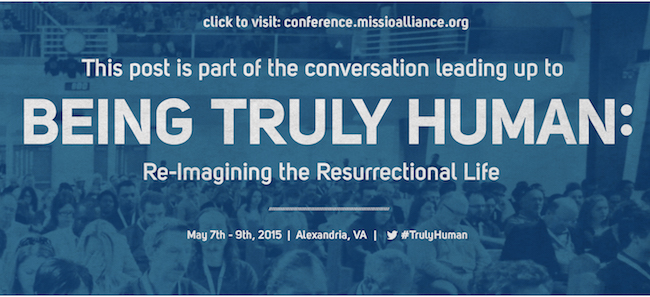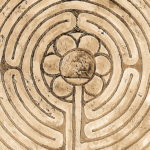In the Christian liturgical year, Lent is a season especially dedicated to spiritual discipline and repentance. The purpose of this discipline is movement toward the resurrection life that is made available to us in Christ, and we repent because the path we naturally follow doesn’t lead to this life. But repentance is a hard thing to manufacture. If the prompting doesn’t come from a place of genuine conviction, discipline is likely to either be motivated by guilt or to produce self-righteousness. In either case, the outcome doesn’t sustain real change.
Three Kinds of Repentance
This is why the repentance that the Christian life calls for is more than behavioral. In Hebrew, there are two words for repentance: שוב shuv (to return) and נחם nacham (to feel sorrow). In Greek, the word metanoia is used, which basically means “to change one’s mind.” So shuv refers to doing differently, nacham to feeling differently, and metanoia to thinking differently.
Thus, repentance, and the change that follows it, touches on all three of these dimensions of human life: thinking, feeling and doing. Those who use the enneagram as a tool for spiritual growth might speak of these three dimension in terms of personality groupings or centers: head, heart, and body. Obviously, everybody engages in all three of these activities, but we are usually most dependent on one of the three – especially in stressful situations. For most people, one center is dominant, another is suppressed, and the third is idle. Much spiritual flourishing, therefore, depends on awakening our idle center in order to resurrect the one we suppress.
Our Greatest Strength and our Greatest Weakness
One big challenge for people on their faith journey then is figuring out which area needs work and how to work on it. It’s actually easier to resurrect the suppressed center than it is to discipline the dominant one. Why? Because the dependent center is not only the activity that is dominant, but it’s also the part of us that other people tend to like the most (if and when they like us). It’s the part of us that we’re known for. It’s the part that’s closely connected to our personality – our small self, as some would say (which is the same thing as the ego-centered self). Paradoxically, this self is called “small” because it tends to be strong, but only when it comes to survival and success in the world.
So the small self “strength” is actually at the same time a weakness when it comes to living a truly human life. This is one of the ways in which the gospel is “foolishness to the Greeks.” Jesus’s call is for a different and more abundant life that inevitably runs counter to the world’s expectations, but it is unexpected not only in terms of the end but also the means. As God says through Isaiah 59, which Paul later quotes in 1 Corinthians 1, “I will destroy the wisdom of the wise; the intelligence of the intelligent I will frustrate.” Jesus brings this prophecy to a head with the command to die to or lose ourselves, pick up our crosses, and follow him.
Some people are feeling or doing-dominant. Figuring out which center you live out of is not very difficult, but it’s not always totally straightforward either. Consulting a spiritual director or counselor is a good idea. In my case, I am thinking-dominant. I deal with anxiety by gathering information and trying to gain understanding. The mind is the “control tower” of the thinking-centered person. As stress increases, I become more detached from reality by retreating into my thoughts. This leads me to stop feeling and suppress doing. So instead of doing whatever needs to be done, I fall into a mode of passively thinking about what’s happening, rather than engaging it in a relational and active way.
Fear not, Judge not, and Peace be with you
It’s interesting that the New Testament and Greek word for repentance starts with the call to change our minds. The majority of people in the world are thinking-dominant, but they are also fearful, and Jesus’s most common command comes from the “fear not” genre. Most people who depend heavily on thinking do not think productively, wisely, or contemplatively. They think anxiously. As such, fear may very well be the biggest human barrier to repentance. The Pharisees were almost certainly a very fearful group.
For others, anger or shame are the great hurdles to overcome for repentance to take place, and Jesus speaks to these as well. Jesus never shames people who are shamed by others. Instead, he takes their shame away by forgiving and healing even the most shamed people in Jewish culture (tax collectors, Samaritans, Roman Centurions, and the sexually or physically unclean). With respect to anger, Jesus only rebukes those whose anger arises from a place of judgment or resentment rather than righteous indignation. To the angry, Jesus says “peace be with you” and “blessed are those who are persecuted.”
A Path to Repentance
We all have strengths and gifts based on our personalities. The trouble comes when we equate our strengths with our identities or use them to chart our path to truly human life. In the market place, good employers hire people based on their strengths — as they should. By contrast, good spiritual leaders, for instance, identify over-dependence on those same strengths, and put forward an alternative program for repentance that disciplines our center of strength.
One of the practices for the thinking person’s repentance is daily silence, meditation or contemplation for about twenty minutes. Over time, this discipline enables the suspension of critical thinking and movement into a more peaceful, trusting state. Another helpful practice for the thinking-centered is reading or listening to stories of others who have done meaningful, courageous work for those who are in need. Stories awaken feelings and move us to new action. They empower us to feel differently and act differently, ultimately causing us to think differently. This is why teachers like Richard Rohr are fond of saying, “We don’t think ourselves into new ways of living; we live ourselves into new ways of thinking.”
The Role of the Church
Because there are at least three different ways that people need to repent, and many more than three different kinds of people, one of the church’s mistakes when helping people along in their Lenten journeys has been to preach only one kind of repentance (usually behavioral) to one kind of person (usually the person who struggles with shame). It’s common, for example, for churches to prescribe one model of mission or growth, or to draw primarily on one theological stream or tradition (the liturgical, evangelical, charismatic, etc.). Is it any wonder, then, that churches are some of the most homogenous communities in our culture today?
The truly human life is about a transformed way of thinking, feeling and doing in the world, freed from fear, shame and anger, and supported by a community who takes courage, trusts and forgives together in the way of Jesus. The whole sweep of Scripture testifies to how God’s grace redeems the full range of human experience, and the gospels bear witness to Jesus’s call for repentance in all dimensions of human activity. Let us as the church, then, be bold and creative enough to make room in our theology and in our practices for the gospel to reach every aspect of people’s lives.
— [Image by Mark Hobbs, CC via Flickr]







Missio Alliance Comment Policy
The Missio Alliance Writing Collectives exist as a ministry of writing to resource theological practitioners for mission. From our Leading Voices to our regular Writing Team and those invited to publish with us as Community Voices, we are creating a space for thoughtful engagement of critical issues and questions facing the North American Church in God’s mission. This sort of thoughtful engagement is something that we seek to engender not only in our publishing, but in conversations that unfold as a result in the comment section of our articles.
Unfortunately, because of the relational distance introduced by online communication, “thoughtful engagement” and “comment sections” seldom go hand in hand. At the same time, censorship of comments by those who disagree with points made by authors, whose anger or limited perspective taints their words, or who simply feel the need to express their own opinion on a topic without any meaningful engagement with the article or comment in question can mask an important window into the true state of Christian discourse. As such, Missio Alliance sets forth the following suggestions for those who wish to engage in conversation around our writing:
1. Seek to understand the author’s intent.
If you disagree with something the an author said, consider framing your response as, “I hear you as saying _________. Am I understanding you correctly? If so, here’s why I disagree. _____________.
2. Seek to make your own voice heard.
We deeply desire and value the voice and perspective of our readers. However you may react to an article we publish or a fellow commenter, we encourage you to set forth that reaction is the most constructive way possible. Use your voice and perspective to move conversation forward rather than shut it down.
3. Share your story.
One of our favorite tenants is that “an enemy is someone whose story we haven’t heard.” Very often disagreements and rants are the result of people talking past rather than to one another. Everyone’s perspective is intimately bound up with their own stories – their contexts and experiences. We encourage you to couch your comments in whatever aspect of your own story might help others understand where you are coming from.
In view of those suggestions for shaping conversation on our site and in an effort to curate a hospitable space of open conversation, Missio Alliance may delete comments and/or ban users who show no regard for constructive engagement, especially those whose comments are easily construed as trolling, threatening, or abusive.